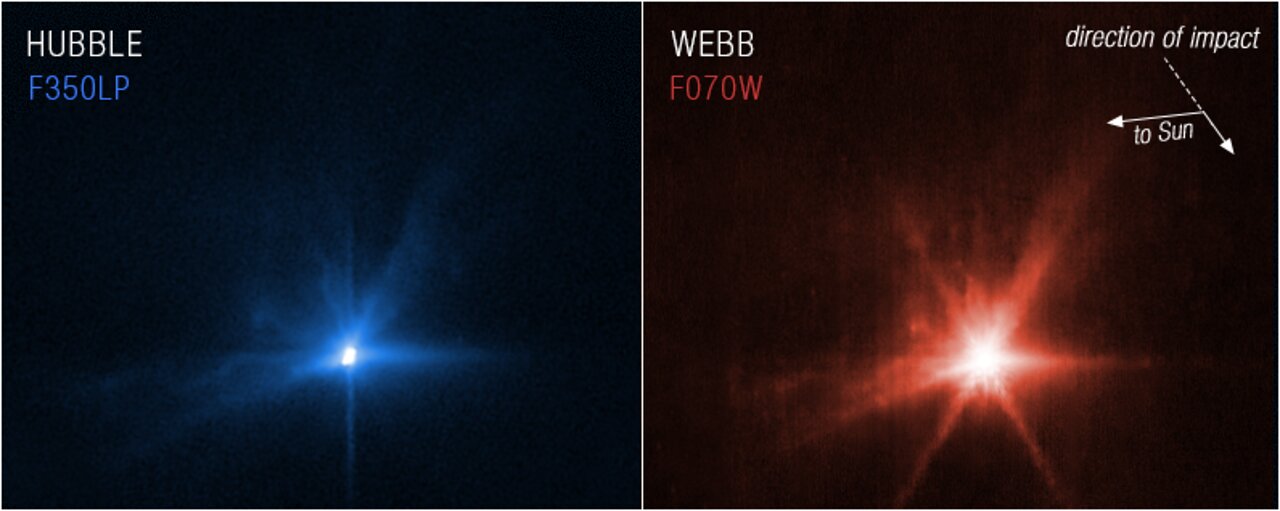
Debris from the impact of NASA's DART spacecraft with the asteroid Dimorphos could reach Earth and Mars, astronomers have concluded. However, while the debris could result in meteors on Mars, it is rather unlikely we'll see a meteor shower on Earth.
DART, the Double Asteroid Redirection Test, slammed into Dimorphos on Sept. 26, 2022, with the intention of testing whether a kinetic impact could nudge the orbit of a potentially hazardous asteroid away from Earth one day. The test passed with flying colors: Dimorphos was pushed into a shorter orbit around its parent asteroid, Didymos. (Neither Dimorphos nor Didymos ever posed a threat to our planet; they were just the guinea pigs in this test).
The impact, which gouged our a crater in Dimorphos, also ejected a large amount of debris. This ejecta formed a cone of escaping material that was observed up close and personally by a small cubesat called LICIACube (Light Italian Cubesat for Imaging of Asteroid), which hitched a ride with DART to view the aftermath of the impact. In particular, LICIACube observed particles a micron (which is a millionth of a meter) and larger being ejected at velocities up to 500 meters (1,640 feet) per second.
Meanwhile, the Large Array Survey Telescope (LAST) and the 28-inch telescope at the Wise Observatory, both in Israel, as well as the NASA Swift satellite's ultraviolet and optical telescope suggested there were additional, microscopic particles released that traveled much faster, between 1,400 and 1,800 meters (about 5,000 to 5900 feet) per second.
Related: NASA's DART asteroid crash really messed up its space rock target
A team led by Eloy Peña-Asensio of the Politecnico di Milano in Italy and Michael Küppers, who is the project scientist for the European Space Agency's Hera follow-up mission to DART that will launch toward Didymos and Dimorphos in October, have now modeled how that debris will spread across the inner solar system. The team's calculations are based on how the gravity of Didymos and Dimorphos, the sun, Mercury, Venus, Earth, Mars, Jupiter as well as the moon, all affect the debris' trajectory.
Their main simulation modeled 3 million particles, split into size groups of 10 centimeters (3.9 inches), 0.5 cm (0.2 in) and 30 microns with velocities up to 500 meters (1,640 feet) per second based on observations from LICIACube.

"Our findings indicate that, given the ejecta cone's geometry and the observed maximum ejecta speed, there are plausible routes for this material to reach Mars," Peña-Asensio told Space.com. "This is our most confident conclusion."
A second simulation was modeled around the higher ejecta velocities suggested by Swift and the ground-based observatories.
"For the second simulation, these faster ejecta are expected to consist mainly of sub-micrometer particles that would not generate meteors when penetrating an atmosphere."
Crucially, the main simulation showed that the slower traveling particles could reach Mars within 13 years of the DART impact, meaning by 2035. Their delivery to the red planet is aided by the fact that the orbit of the Didymos–Dimorphos binary around the sun crosses the orbit of Mars. That means the ejecta doesn’t need to be traveling as fast or as far to reach Mars as it does to reach Earth. In fact, the main simulation showed that none of these slower moving particles will reach Earth.
However, the second simulation is a different story. It implies that fast-moving ejecta could arrive at Mars within 5 years of the DART impact, and at Earth as soon as 7 years after the impact, in 2029. Yet, given the tiny size of these particles reaching Earth, they would not create a visible meteor shower. This would only happen if some larger particles sneaked through somehow.
"In our main simulation, no particles reach Earth at velocities up to 1,000 meters (3,280 feet) per second," said Peña-Asensio. "Only particles ejected at velocities of 1,500 meters (4,900 feet) per second or higher reach Earth, and this occurs exclusively in the secondary simulation."
"However," the researcher added, "if these particles were slightly larger or if LICIACube missed macroscopic particles at these speeds, it would be possible for them to reach Earth and produce observable meteors. Only future meteor observation campaigns can verify this."
The simulations were even able to show where the ejecta arriving at Earth and Mars would come from. The debris that could create a meteor shower on Mars in 2035 comes from the northern part of the impact site, whereas the smaller, fast-moving particles that might reach Earth would come from the southwestern part of the resulting crater.
"Impacts like DART and the resulting ejecta highlight the ongoing exchange of material between planetary bodies, asteroids, comets and other celestial objects," concluded Peña-Asensio.
So, while Earth's skies probably won’t be lit up by a meteor shower from Dimorphos' debris, the Mars rovers might enjoy a display of shooting stars next decade.
The research is available as a pre-print on the paper repository arXiv.







